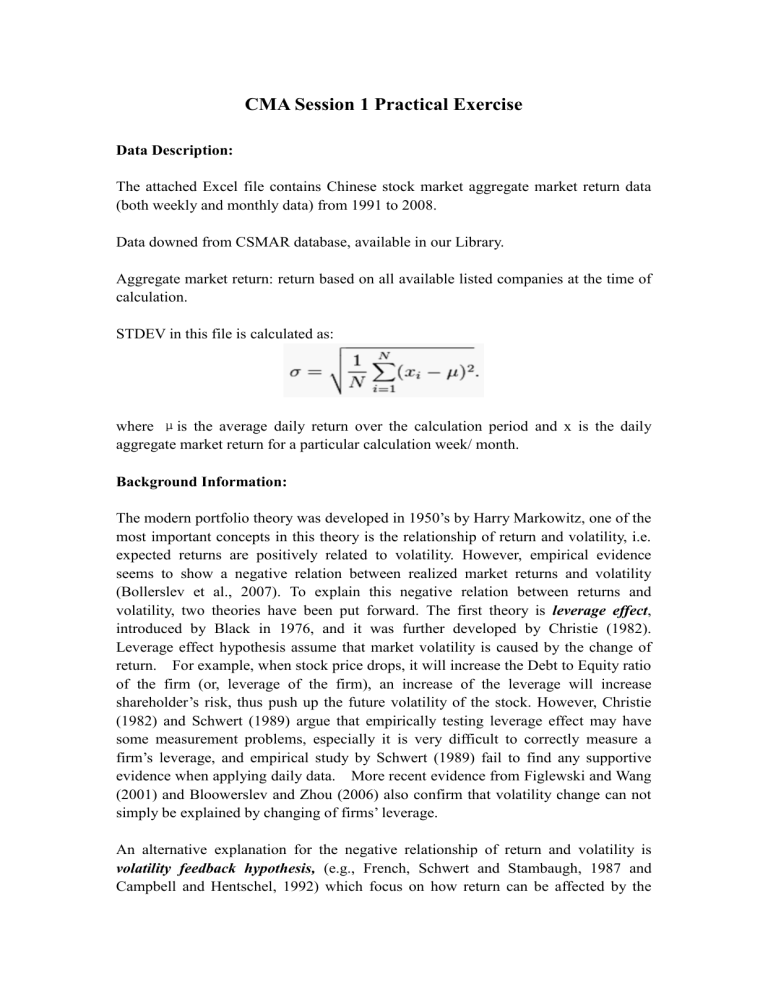
CMA Session 1 Practical Exercise Data Description: The attached Excel file contains Chinese stock market aggregate market return data (both weekly and monthly data) from 1991 to 2008. Data downed from CSMAR database, available in our Library. Aggregate market return: return based on all available listed companies at the time of calculation. STDEV in this file is calculated as: where μis the average daily return over the calculation period and x is the daily aggregate market return for a particular calculation week/ month. Background Information: The modern portfolio theory was developed in 1950’s by Harry Markowitz, one of the most important concepts in this theory is the relationship of return and volatility, i.e. expected returns are positively related to volatility. However, empirical evidence seems to show a negative relation between realized market returns and volatility (Bollerslev et al., 2007). To explain this negative relation between returns and volatility, two theories have been put forward. The first theory is leverage effect, introduced by Black in 1976, and it was further developed by Christie (1982). Leverage effect hypothesis assume that market volatility is caused by the change of return. For example, when stock price drops, it will increase the Debt to Equity ratio of the firm (or, leverage of the firm), an increase of the leverage will increase shareholder’s risk, thus push up the future volatility of the stock. However, Christie (1982) and Schwert (1989) argue that empirically testing leverage effect may have some measurement problems, especially it is very difficult to correctly measure a firm’s leverage, and empirical study by Schwert (1989) fail to find any supportive evidence when applying daily data. More recent evidence from Figlewski and Wang (2001) and Bloowerslev and Zhou (2006) also confirm that volatility change can not simply be explained by changing of firms’ leverage. An alternative explanation for the negative relationship of return and volatility is volatility feedback hypothesis, (e.g., French, Schwert and Stambaugh, 1987 and Campbell and Hentschel, 1992) which focus on how return can be affected by the change of stock’s volatility. In a theoretical model by Campbell and Hentschel (1992), they show that increase in current period volatility will increase future expected return, in the absence of news of future cash flow, higher future expected return means an immediate price drop, thus we should observe a negative current period return when volatility rise. Volatility feedback hypothesis is supported by Glosten et al. (1993) and Engle and Ng (1993) in their various GARCH models testing. Comparison studies by Bekaert and Wu (2000) and Wu (2001) find volatility feedback effect received more empirical support compared with leverage effect. Questions: 1, How to measure risk 2, Show summary statistics for Chinese aggregate market return and volatility. 3, Exam the serial correlation for both realized return and volatility (both weekly and monthly). 4, Think of the subjective risk measurement, and examine whether it is superior to the traditional risk measurement method. 5. Examine the relationship between risk (subjective risk and realized risk) and return in Chinese stock market.






![[These nine clues] are noteworthy not so much because they foretell](http://s3.studylib.net/store/data/007474937_1-e53aa8c533cc905a5dc2eeb5aef2d7bb-300x300.png)